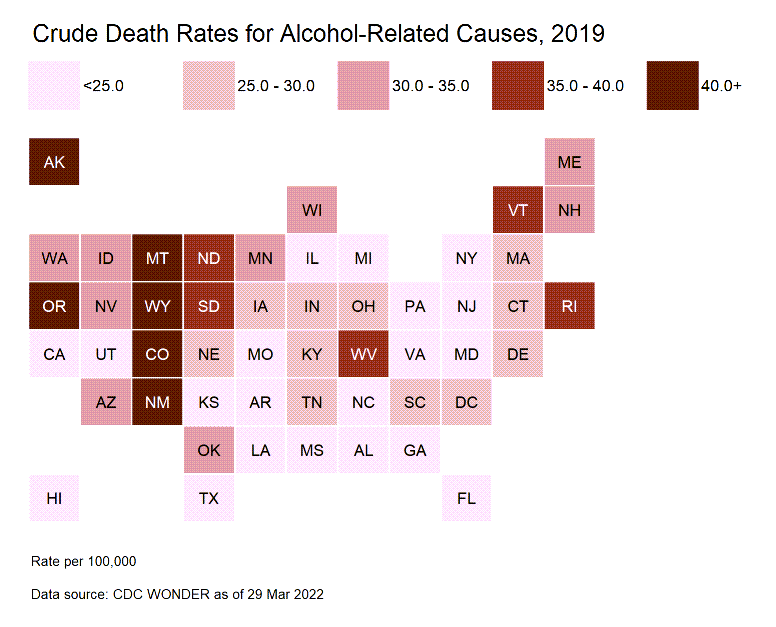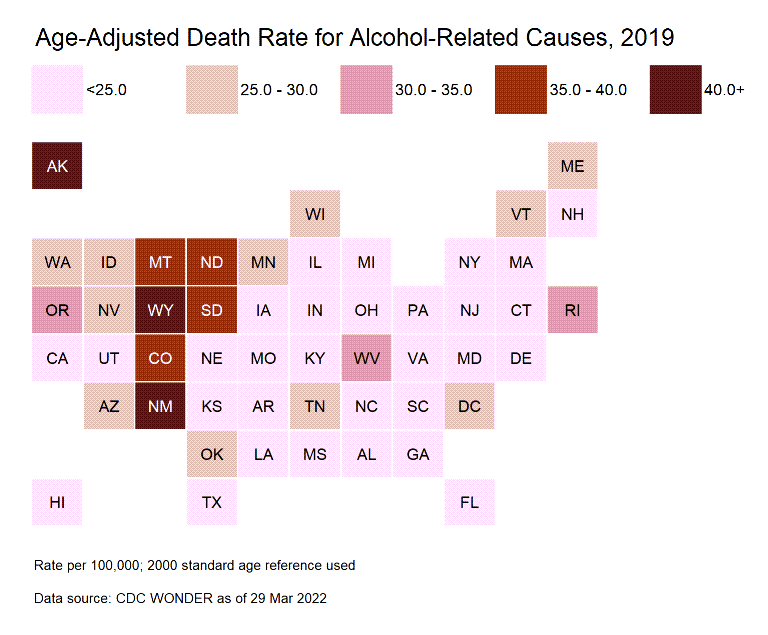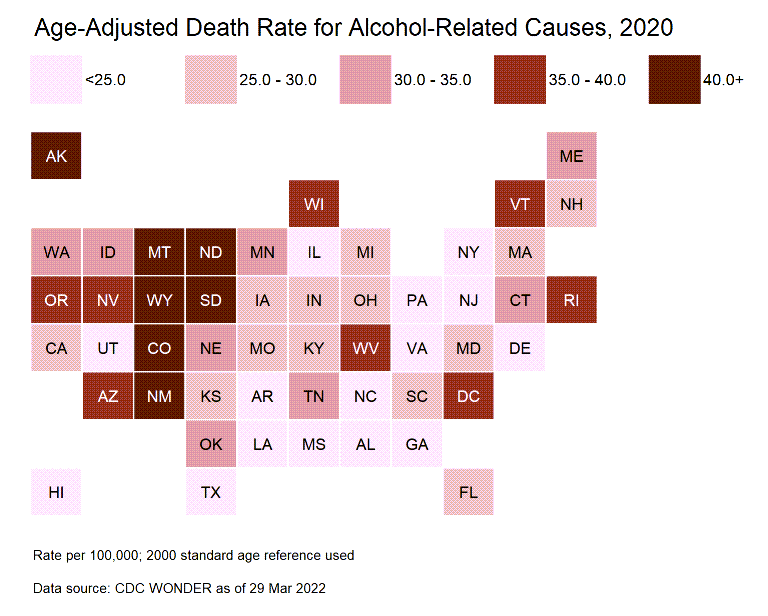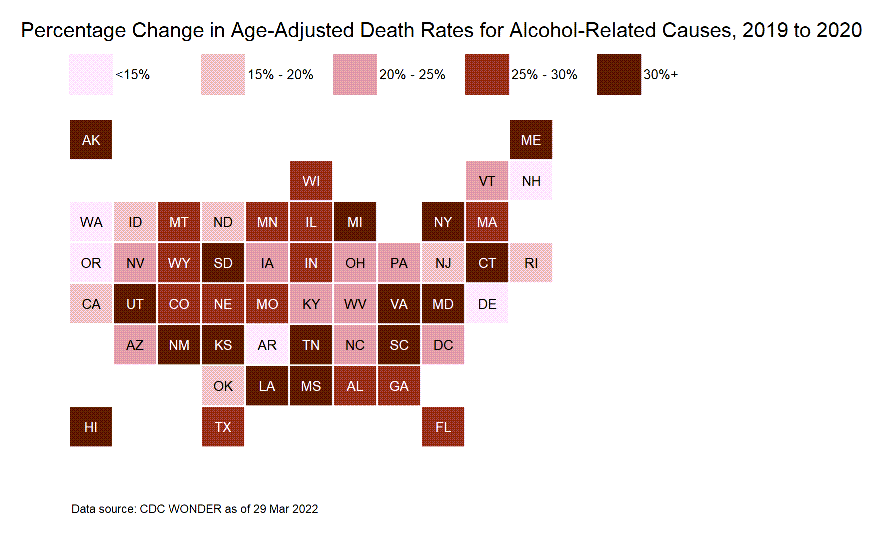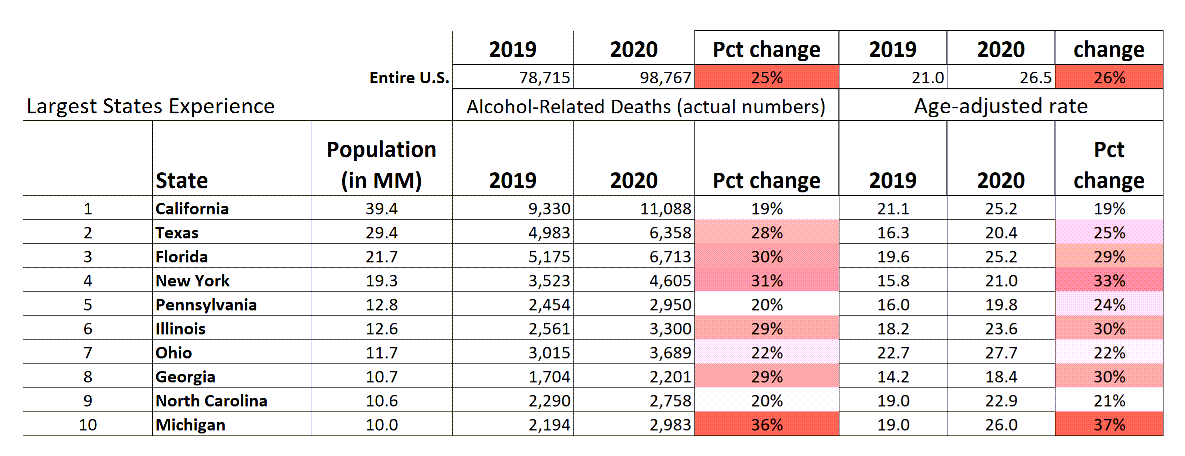Alcohol-related deaths, part 2: Geographical Differences for 2019 and 2020
Western states lead in rates; all states increased in alcohol-related deaths in 2020
Part 1 can be found here: Dead is dead: Increased Alcohol-Related Deaths, U.S., 2020-2021
Go to the bottom of this post for an index to all the nasties (drug overdoses, homicides, suicides, motor vehicle accidents, alcohol-related deaths), as well as methodology.
Later this week I will be posting an update on 2021 mortality (all causes of death). More at the very bottom.
Top-level results:
1. The highest death rates for alcohol-related causes are in the western region, stretching in a band from New Mexico to Montana, and the relative ranking held across 2019 and 2020.
2. All states saw an increase in alcohol-related deaths between 2019 and 2020.
3. While there is a clear geographic pattern to the crude and age-adjusted rates, there was no clear geographic pattern to the percentage change in rates between 2019 and 2020.
Baseline alcohol-related death rates in 2019 — crude rate and age-adjusted rate
2019 crude rate of death for alcohol-related deaths:
Age-adjusted death rate for 2019:
I will note that for these graphs, there is a closeness among many of the states for rates. The vast swath, in 2019, are at the lowest grouping for age-adjusted death rates — 60%, in fact.
I’m not trying to be deceptive, but because I wanted comparability between all four graphs of the two types of rates and two years, I wanted the same breakpoints. I played around with a lot of different breakpoint choices before I settled on these. You will see below that while 60% of the states were in the lowest category for age-adjusted death rates in 2019, in 2020, only 30% were – it’s the nature of the across-the-board increase.
It does make it difficult to distinguish between the states’ starting points, however.
Yes, it does make the western states stand out in 2019.
While I don’t think anybody was particularly surprised by Alaska being high on the alcohol-related deaths map, it’s interesting there’s a band stretching from New Mexico to Montana — plus Oregon, Vermont, and Rhode Island. Not sure what’s going on with VT and RI, other than potentially being small population states and getting thrown off by having some “rugged individuals” doing some stupid things.
Or perhaps they prefer to kill themselves with booze instead of fentanyl. It’s a choice, of sorts.
2020 distributions for alcohol-related death rates
As noted above, I’m using the same breakpoints for color scales as in 2019, and now we can see most states go darker.
2020 crude rate of alcohol-related causes:
Age-adjusted death rate for 2020:
We will get to percentage changes in the next section, but pretty much everybody gets darker. Of course, that’s because a large category of alcohol-related deaths are motor vehicle accidents (aka drunk drivers).
Interestingly, states with a tradition of mass transit/taxis like New York and New Jersey keep their relatively low rates.
I will admit, when I moved to NYC, I definitely started drinking more, and the biggest reason was I didn’t have to worry about driving anywhere. Somebody else was going to be getting me home (though, most of the time, it was the subway or the train.)
Similar to drug overdoses, one can see that the “footprint” of the high alcohol-related death rates seem to spread out geographically.
I am sure that various drug and alcohol programs do consider acuteness in their programs, in that some areas have certain drug addictions as more of a problem, or drunk driving as more of a problem, for their local communities. I see West Virginia is ranking on the 2020 map, where it was top with opioid problems as well.
This is the point in such a large country as the U.S., when it comes to public safety — it is all very well to have national programs to reduce drunk driving, for example, but some states obviously have much worse problems than others.
Percentage change from 2019 to 2020
Percentage change for crude rate from 2019 to 2020:
Percentage change for age-adjusted rate from 2019 to 2020:
Patterns here are much less clear, as had been seen with some of the other geographic analyses of change. In some cases, states with high rates didn’t have much higher to go, and states with low rates had a lot of room to jump higher.
I am not sure there is much of a cause-effect analysis I can discern here, or not in a geographic sense. There may be analyses that can be made in terms of economic variables or public policy, via regression analysis, but not geographic analysis.
So, I will just present these charts to the reader, and the spreadsheets are below for anybody who want to take the data and run with it.
Tables for largest states and for the states with the worst alcohol-related death rates
To give you an idea of what the data look like, here are two extracts, just showing the 10 largest states by population:
Largest states:
I want to show how the large states did, just so you can see some of these numbers in context.
The overall country, comparing full-year 2019 against full-year 2020, increased 25% in alcohol-related deaths (not to be confused with my prior 33% increase number, in which I excluded January 2020-March 2020, and included 2021 experience).
Most of these states have age-adjusted death rates from alcohol-related causes within spitting distance of each other and the national average, with the lowest being Georgia, at 18.4 in 2020 (hey, the Bible Belt has some upsides) and the highest being Ohio at 27.7. Ohio’s average is only a little bit higher than the national average of 26.5, though.
The highest percentage increase from 2019 to 2020 we see is from Michigan, of 37%, but its 2020 age-adjusted death rate was below the national rate.
Let’s look at the states with the worst rates
Worst rates:
We see that the states with the worst age-adjusted death rates from alcohol-related causes generally had lower percentage increases compared to the national average. Except South Dakota. Holy hell, SD, dry up.
[Looking away from New Mexico]
All these are relatively low population states, with the largest state being Colorado, at 5.8 million people. Colorado is #21 by population in the U.S.
I note that even with disparate percentage increases, all these states maintained their relative rankings in 2019 and 2020, which is… hmmm. Well, I suppose that can happen.
Looking at these high rate states, what many have in common is that they are big and empty (of people) — long, empty places one can drive…. right into the side of a mountain. Or a building. Maybe people get bored and find drinking to be their sole entertainment. Now, not all are this way – but a lot of these are “outdoor sports” types of places, and I have friends in places like Colorado and Oregon. They are kind of “party” types of places. Like NYC… but without the taxis.
Autonomous vehicles will be a real boon, once we get them, and they’re affordable.
Get on it, Elon!
Sober up, America
The alcohol-related deaths are not necessarily all “external” — it cuts across all cause types, including such items as motor vehicle accidents (drunk driving) as well as “natural” causes (e.g., cirrhosis).
I wasn’t expecting to add this one to my list of “nasties”, but it is significant in that it’s a category that deserves looking at. We’re not going to be doing Prohibition 2: Electric Bugaloo, but there are things we can do to reduce the mortality impact, at least.
I have extended my index of the nasty non-COVID causes of death (not that there are “nice” causes), listed below.
Suicide
Suicide: Trends, 1968-2020, and Provisional Counts Through June 2021 – this one had only one standalone post, but I’m not done with this topic yet.
Mortality Nuggets: Videos on Suicide Rate Trends, Society of Actuaries Report, and Fixing Their Graph — there are a variety of mortality trends covered in video form here, and suicide rate trends are in the first video.
Homicide
Homicide: Trends, 1968-2020, and Provisional Counts Through June 2021
The Geography of Homicide — States, Base Rates, Increases, and Correlations
Motor vehicle accidents
Motor Vehicle Accident Deaths: High-Level Trends, 1968-2020, Part 1
Motor Vehicle Accident Deaths, Part 2: Age-Related Trends with Provisional Results in 2021
Motor Vehicle Accident Deaths, Part 3: Geographical Differences, 2019 vs 2020
Drug overdose deaths
Drug Overdoses, Part 1: High-Level Trends, 1999-2020
Drug Overdose Deaths, Part 2: U.S. Age-Related Trends 1999-2020 with Provisional Results in 2021
Drug Overdose Deaths, Part 3: Geographical Differences for 2019 and 2020
Alcohol-related deaths
Part 1: Dead is dead: Increased Alcohol-Related Deaths, U.S., 2020-2021
Part 2: Alcohol-related deaths, part 2: Geographical Differences for 2019 and 2020
As a reminder, I have a Mortality with Meep category, if you want to only look at mortality-related posts (I do write about other things, like public finance).
As noted at the top, I have been looking at the full-year 2021 results. In February, I had looked at some preliminary 2021 mortality, but really, I didn’t have enough at the time to do more than make some comparisons between states.
I have some very nasty results to share for 2021. It was worse than 2020. Yes, a lot of that was Covid, but for the age groups hardest hit in a relative sense (that is, with the greatest increase of deaths compared to a 2019 baseline), most of their increase didn’t come from Covid.
If you look above, you can guess where a lot of the increase did come from.
So we have that to look forward to, together.
Methodology
In the above, I used the multiple cause of death (final only) database in CDC WONDER, using a method similar to the JAMA researchers from post part 1, with a few differences.
In their research, and in my numbers, I used alcohol-related causes of death from any contributing cause of death (there are up to 20 contributing causes on a death certificate). They provided a list of ICD-10 codes they selected from. I simply selected A (Alcohol-induced causes) from the “MCD – Drug/Alcohol Induced Causes” list. I believe this will be the same set of codes. I pulled for 1999-2020, all available dates, grouped by year and state, but for the analysis used only 2019 and 2020. If this is the substack post, you can download my spreadsheet below and see the full history of results, as you may find that interesting.
In the prior post, I excluded deaths where the underlying cause of death (and there is one and only one of those per death certificate) was COVID (U07.1). This ultimately removed 1,474 COVID deaths that were alcohol-related in 2020. However, upon examination, I found this amount of deaths, when divided by state for this post’s analysis made no significant difference in terms of rankings or major significant figures for rates or percentage changes, I didn’t bother making adjustments to state rates. I kept the COVID deaths in for each state.
In addition, I pulled data at a later date (29 March 2022 for this post) than the researchers did. The researchers were not looking at geographic changes, and I was, obviously.




